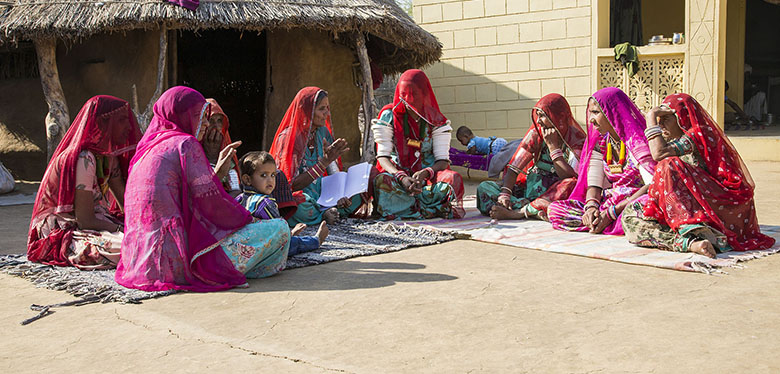I originally wrote this article for the Center for Sustainable and Development Studies Blog Series.
Climate change remains one of the greatest threats to achieving sustainable development, and its effects often fall hardest on women. I have written this blog to share several points that I find important after reading articles and blogs tackling gender within the issue of climate change.
 Indian women discussing challenges and solutions relating to common property resources in their village
Indian women discussing challenges and solutions relating to common property resources in their village
Source: CGIAR
Climate change is not gender-neutral, its impacts affect women and men differently across societies. In many instances, climate change has negative implications for women, increasing their vulnerability because of their lower social, economic, political, and legal power, especially in developing countries. Women in poor rural communities use natural resources in different ways than men, as they possess fewer assets. From food preparation to sourcing of water, fuel, and wood, women are more vulnerable to climatic changes that affect these resources. Having grown up in a developing country, I witnessed this every day at multiple scales; within my own household, around my neighborhood, and in marginalized areas as I traveled around for research purposes. That may be interesting to some of you, but in most developing countries and emerging economies, women still use cookstoves that rely on biomass as their primary source of solid fuel, wood, and charcoal being the most common
In agriculture, female agricultural workers are confronted with severe unequal access in terms of land, finance, and vital farm inputs e.g. seeds, fertilizer, and irrigation to name a few. A quick search on google would present you with a number of case studies from Bangladesh to Africa on how the vulnerability is differentiated by gender on the impacts of climate change. For example, a study has reported that in Malawi, more girls dropped out to save money and assist with household tasks than boys after a drought. So not only does climate change reduce the chances to achieve gender equality but it also aggravates existing ones.
It is important to remember, however, that women are not only vulnerable to climate change but they are also powerful actors of change in relation to mitigation and adaptation. As knowledge banks and managers of household resources with expertise that can be used in climate change mitigation, disaster reduction, and adaptation strategies, women are positioned to contribute to livelihood strategies adapted to changes in climate (UNDP, 2011). According to UNESCO, “understanding and effectively taking into account the gendered dimension of climate change is key for achieving the Sustainable Development Goals (SDGs)”. The UN has also concurred that “successful action on climate change depends on the engagement of women as stakeholders and planners in ensuring that everyone has access to the resources they need to adapt to and mitigate climate change”.
However, women’s contribution to the fight against climate change is still marginalized. According to a study in the Regional Environmental Change, this can be attributed to the “lack of extensive discussion in the gender dimension of climate problems and adaptation responses emanating from limited participation by policy actors, especially female policy actors, with an explicit perception of the gender dimension as an issue of implementation”. More so, another study suggested that this may have contributed to the lack of political commitment to address climate change. This is a bit disappointing as studies have shown that female politicians have been associated with outcomes that include better quality of institutions and higher rates of economic growth. Moreover, attitudes towards climate change identified in the general public suggest that females have greater awareness and concern about climate change than males do. Recently, a study in the European Journal of Political Economy investigated whether female political representation in national parliaments influences climate change policy outcomes. The study concluded that it leads countries to adopt more stringent climate change policies and results in lower carbon dioxide emissions and may be an underutilized tool for addressing climate change. In addition, the study has suggested that various international campaigns to address climate change may succeed more in places where more females are represented in political power. Furthermore, affirmative action in various forms to increase female representation in politics may result to increase in countries’ commitments to address climate change. If you have not noticed, young schoolgirls are now on the front lines of the very popular school strikes for climate, putting pressure on governments forward the climate action agenda .
To conclude, yes, we still need to talk about gender within the issue of climate change. There still exists a need to improve our understanding of factors that hinder or facilitate the emergence of gender-responsive climate change policies. A critical examination of policy interaction discourses and institutional setting and the inclusion of represented actors, particularly women, should be taken into consideration to explicitly address gender issues in the discussion
References:
- Mersha, A.A. and van Laerhoven, F., 2019. Gender and climate policy: a discursive institutional analysis of Ethiopia’s climate resilient strategy. Regional Environmental Change, 19(2), pp.429-440.
- Mavisakalyan, A. and Tarverdi, Y., 2019. Gender and climate change: Do female parliamentarians make difference?. European Journal of Political Economy, 56, pp.151-164.
- Yadav, S.S. and Lal, R., 2018. Vulnerability of women to climate change in arid and semi-arid regions: The case of India and South Asia. Journal of Arid Environments, 149, pp.4-17.